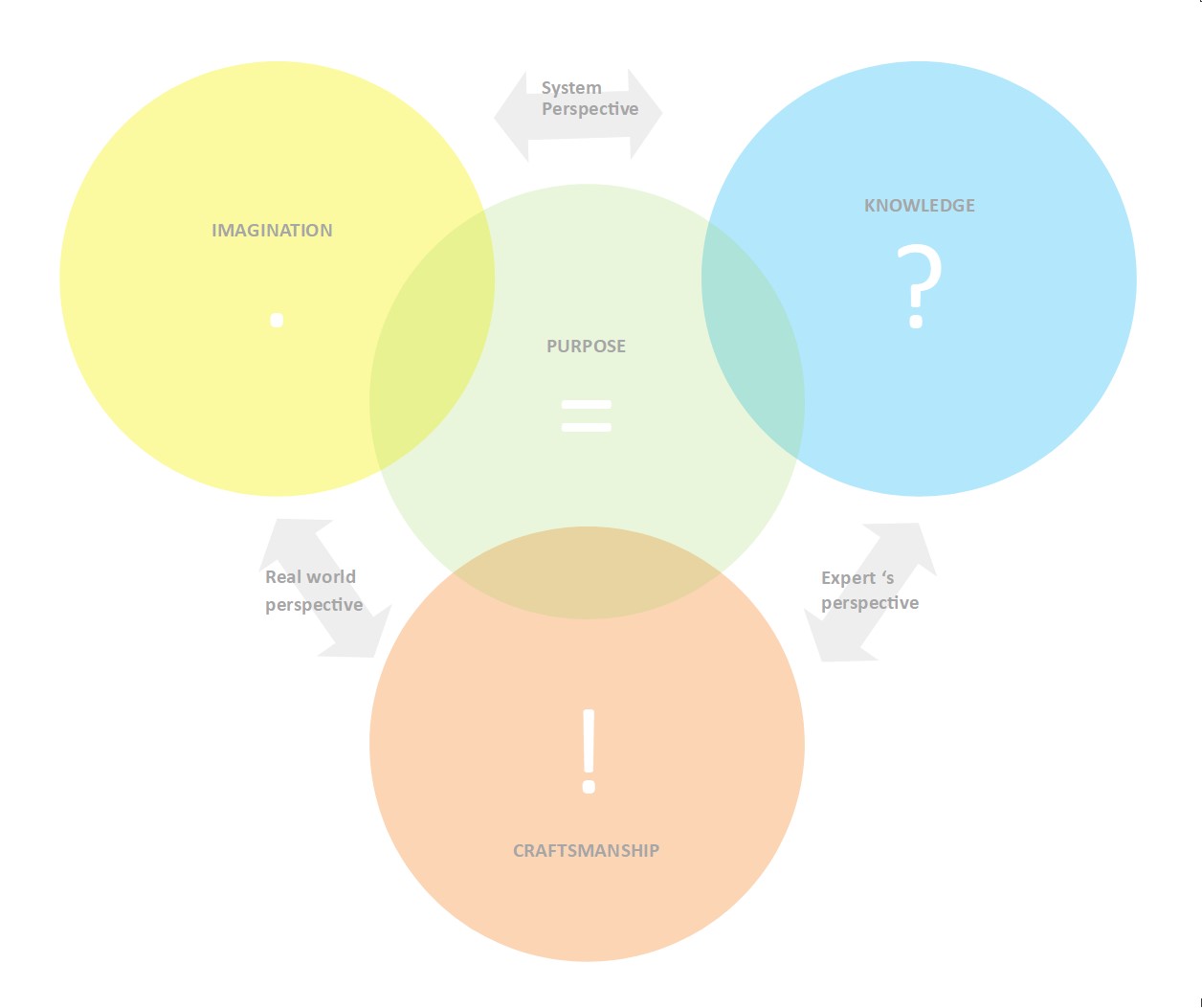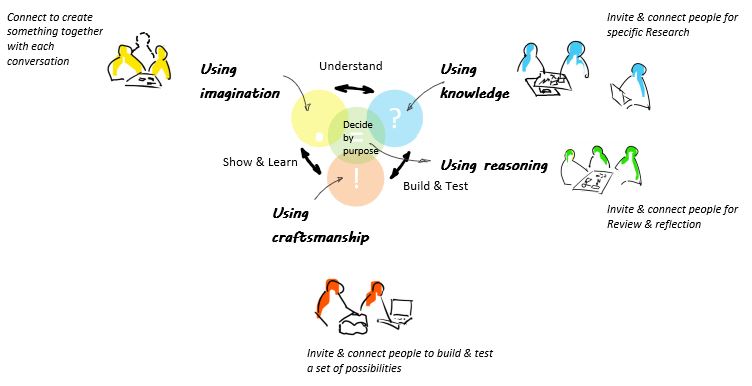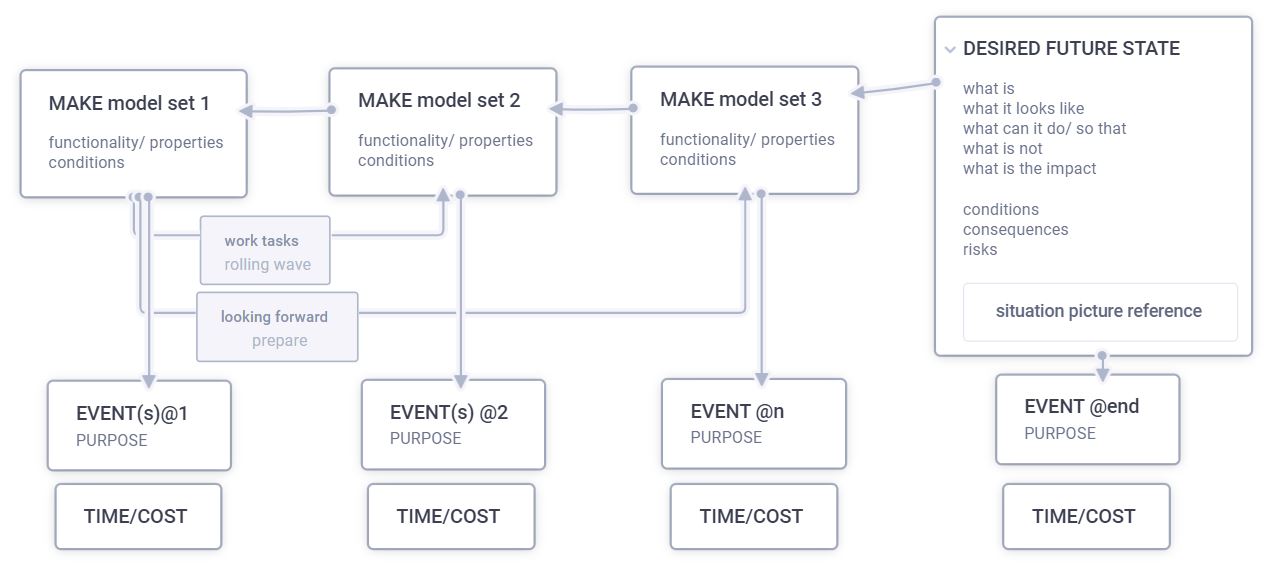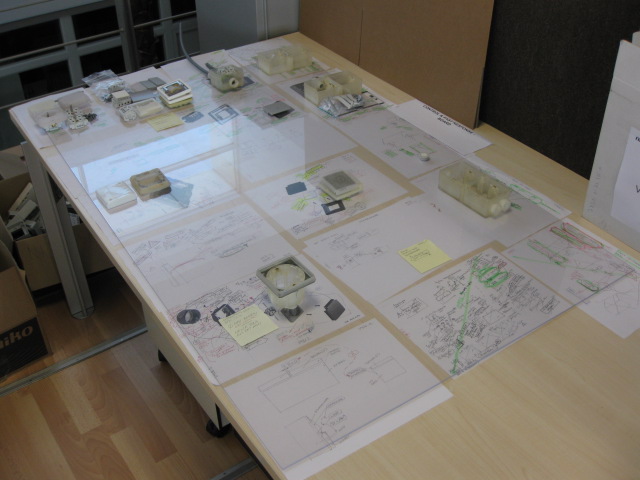In two previous posts you can read how ideas come into a project (How to make ideas grow into a project. From vision to project teams) and how a core teams quickly set up a project
(How to set up and run a project. The Project Table set up for core team professionals)
With the project set-up, a core team has the associated management tools as a tangible, unambiguous perspective from which to work. A network of external participants can be set up to bring the necessary knowledge and expertise to the project group. The focus is now on the development of products-services-systems in which everyone is involved simultaneously, as early as possible.
The core team is confronted with many differences in work culture (and methods) and with intentions to immediately look for solutions with knowledge. To avoid the collaboration groaning under discussions about work habits and to ensure that those involved can use their own methods, the core team has an overarching model to organize continuous development in a smooth flow and cut the crap.
“Collaboration is one of the most important and yet most delicate capabilities an organization can develop…too often we see collaboration being eroded by systems, structures, and above all mindsets that make people focus on their own interest and their own interest only…Short-termism, selfishness, and risk avoidance all lead to less collaboration. People opt for their own targets and do no longer share their assets, or start negotiating and demanding certainties…To overcome the barriers to collaboration people need to experience trust and meaningfulness” – David Ducheyne
Visioning-Development-Planning: a collaborative systems design approach.
Visioning-Development-Planning is the engine to drive the development of products and systems. It involves realizing new systems or adapting existing ones, with visioning or craftsmanship as the starting point for creating, rather than relying solely on knowledge. It connects people to there work and creates a culture of trust and collaboration within a learning environment. It’s about fascinating people, arousing their curiosity and challenging them to participate.
With one visual anchor, people can manage themselves and each other flexibly. It guides professionals to quickly run and keep rolling through all aspects of the design. Participants can easily anticipate and see how they can contribute to the success of a project.

How to run and keep rolling through all aspects of the design and how participants can contribute:

The method makes things understandable and tangible by visualizing situations from a systems perspective and creating models with associated properties. The guidance provided by the design stages makes it possible to create with an open mind during conversations, and conclude with a written understanding in ‘only necessary’ documentation. It doesn’t matter which stage you start with , every bit of thinking and doing falls back into the right context from the inception of an idea to getting production.
Visioning:

“Logic will get you from A to B. Imagination will take you everywhere”. Albert Einstein
- It is: a moment for using imagination without using knowledge and technology, free from all judgment. Making your point!
- What you do is: Shape your thoughts, placing elements and their inter-relationship in context.
- What you make is: it is creating, a fast hand drawing sketch-like representation of the situation and the context. Best is to use pen and paper/screen to draw and bring people in.
- Why: to capture individual and collaborative thinking without limiting creativity through the use of technology. To fascinate and inspire.
- Examples: sketch-like representations of a concept of your vison or opinion, of a conversation/ communication, of an observation.
You can organize vision sessions: people make situations visible/tangible from their imagination, everyone gives their own view. The visual representations are put together, similarities and differences then come together in a common vision recorded in an explanatory sketch or prototype.
Closing your eyes when imagining situations and listening to conversations helps to draw the context, I learned from a blind friend. I have been doing that ever since, it sharpens the attention enormously and creates a pleasant calm.
Vision can be difficult to transfer into strategy, which requires the system approach that makes further development possible.

- It is: a moment of framing from a systems perspective, understanding the situation as is/ as can be.
- What you do is: giving meaning to the situation picture, to understand it as a system that everyone understands, to understand what the higher purpose is. Asking what, who, where, when, why, how, how much.
- What you make is: the enriched situation sketch with labels for what you know and what you don’t know (knowns and unknowns).
- Why: to have a clear picture of a situation to share, connect with people and build up. People who can see where their ideas can fit in a system, are more prepared to collaborate.
The expected quality is not always easily known and will be discovered in further research. Unknown unknowns can pop up in research
Development:

- It is: a moment for using knowledge, exploring unknowns.
- What you do is: Exploring the system picture of the situation from different knowledge perspectives, to discover needs. Put and see the system in a larger system (the whole system and it’s environment). Explore how things can look like- what things can do- what processes are going on.
- What you make is: a set up of system model sets, with the larger system broken down into levels, viewed through more knowledge lenses, labeled with knowns and unknowns.
- Why: to stimulate curiosity and research. Bring in expertise, professionalism and experience and learn.
Even if you know solutions, take the opportunity for a short conversation with your knowledge network and peers, a quick glance from an outsider always gives inspiration and quickly turns you into an expert too.
In my job as a technical designer and engineering manager (80’s-90’s) I regularly called experts in different fields of knowledge and made myself a more than educated expert, free of charge and with an ever stronger bond of friendship.
To provide solutions to needs, you connect with expertise, experience and knowledge, the system model sets are the basis to build on.

- It is: a moment for using technology and expertise, for making things work, materializing, crafting and testing.
- What you do is: developing and testing the desired situation, designing multiple solution proposals for system parts and sub-aspects and exploring and ensure the chance that the solution proposal will work.
- What you make is: drawings or sketches to give a solution to a problem with the data for making a set of samples.
- Why: to prepare for creating tangible evidence. People are fascinated when they see they build things and discover the purpose of it.
The quality of proposed solutions is not always easily to prove and will be discovered in testing and research. Unknown unknowns can pop up in testing and validation

- It is: a moment for using craftsmanship.
- What you do is: Create and test the developed solutions, create a working model (model set) with the developed properties, measure the properties and the quality.
- What you make is: working things, fast (low cost) prototyping and sampling up to the final model is ready to use. It can be acting in (virtual) reality.
- Why: to reward curiosity and learn by playing and testing. People are driven to make something that they can show.
Everyone should be able to show their contribution provided they are clear about what and what is not shown.

- It is: using events to show and test solutions.
- What you do is: show and validate the working model with associated properties, validate what has already been created from the user and customers perspective (best in it’s real environment).
- What you make is: a setting where it is possible to experience the functioning of a model in the best possible reality.
- Why: confront users and customers with the status of the design and research to discover needs and serious shortcomings. And in the interest of the contributors to be able to show the beauty of what they have made.
The core team is present to lead validation events and when enthusiasm rears its head they shift the mind to curiosity to feed insights back into the initial representation of the situation, its context and associated conditions. From there they think it over what changes are with its impact, using imagination.
It doesn’t matter which phase you start with, every bit of thinking and doing falls back into the right context from the inception of an idea to getting production, as long as there is a reason and that preparation can be planned.
Planning:

- It is: a moment of reasoning.
- What you do is: reviewing and reflecting of whatever comes up, a team should ask: “why we do this for, to make/achieve what”, “what can we do with what we have now”.
- What you make is: a state of “where you are and what you really (don’t) know” and decisions about the purpose for which one of the fragments in a creation cycle is turned on to proceed with the best next actions.
- Why: to be aware of purpose and building trust in collaboration with people, avoid mistakes and unnecessary useless effort, appreciate outcome, learn, and do something [for) with what you (not) have.
- Examples: short question & answer moment, give & take discussion, organized reviews, reflecting sessions, planning session, prioritizing, documenting and communication of information.
A creation of a (partial) solution is only ready when all aspects/stages of the pattern have been completed, even if this is deliberately very short. Gaps in the cycle due to a lack of time or forced pressure make the professional aware of possible consequences for the quality of the development.
The core team makes decisions in projects and spread the right information with knowledge of the whole context. Dot voting is not a decision method in the creation cycle and communication does not go through PowerPoint presentations and email. All information is recorded in only necessary documentation to help the team post and recover knowledge and the right information quickly.
- The system description records what is expected (requirements) and what has been realized (properties), with the associated system drawings (sketches, CAD, exploded views…) it is the source for all derived information flows (such as test and review events, bills of materials, marketing and sales campaigns, training and instruction data…).
- The model description records the state and source of prototypes and samples with a label ID to reference it in related test and review reports.
- Review and decision description records what, when and how is assessed, by whom based on which reference and criteria. With a list of comments – impact – cause – actions and a final conclusion.
The model strategy pulls the activities to make the development.
A clear picture of the expected situation is the starting point for a plan of working models that must be made with an expected quality and delivery date linked to events (show & review moments, tests, training, promotion, delivery). Each strategic point is drawn with model specifications for what it is, what it looks like, what it can do and what is done with it. The strategic points pull the work that needs to be done to make that happen. The focus is on ‘making things’ and not on ‘doing things’. For the sake of understanding, this is not a type of MS-Project plan, but a visual control board (Model-Quality-Event plan) and a task board of your choice. At each strategic point that is ready, a model stands as a reference for what has already been made.


With the ProjectTable (ref. to post: ‘How to set up and run a project. The Project Table set up for core team professionals’) and Visioning-Development-Planning you’re in the driver seat to organize projects and keeps a collaboration running optimally and effectively in an ever-changing situation. These visual anchors help professionals work at their best, without getting frustrated with the pressure some people put on the project. Responsibility becomes apparent when the professional can respond to some aspects of development that are not taken seriously.
Visioning-Development-Planning assists professionals and teams to be able to orchestrate all elements of product and systems development at the same time.
Do you also want to work like this? Questions about how to approach that? please contact me today.
Did you find this post interesting? Share it with your network!

